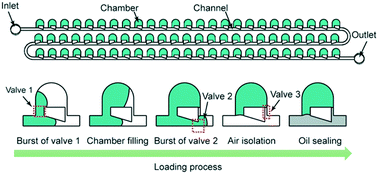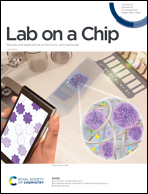A scalable microfluidic chamber array for sample-loss-free and bubble-proof sample compartmentalization by simple pipetting†
Abstract
Sample compartmentalization is a pivotal technique in many bioanalytical applications, such as multiplex polymerase chain reaction (PCR) and digital PCR (dPCR). In this study, we successfully developed a novel self-compartmentalization device containing an array of microchambers, each of which is connected to a main microchannel with three capillary burst valves (CBVs) for fluid switching and partitioning. As these CBVs can be automatically opened in a predefined sequence, an incoming solution can be spontaneously directed into the chamber and held in place without further mixing. After that, either air or oil can be loaded into the main channel to isolate each chamber completely. By optimizing the relative burst pressures of the CBVs, a 100% sample utilization rate can be achieved even using a manual pipette and air bubbles in the sample cannot interfere with the loading. In addition, the number of the microchambers in an array can be easily scaled from a few to tens of thousands. To verify the feasibility of this self-compartmentalization method, we successfully conducted mock multiplex loop-mediated isothermal amplifications (LAMP) in an array that contains 144 microchambers, proving that our design method will provide a robust and versatile platform for various sample discretization purposes in the future.



 Please wait while we load your content...
Please wait while we load your content...